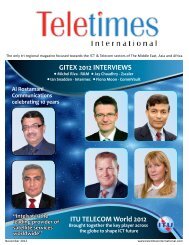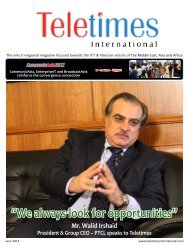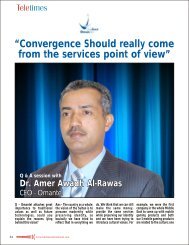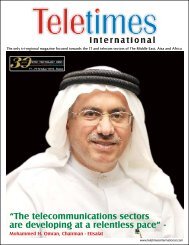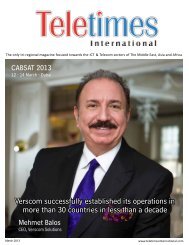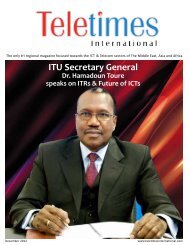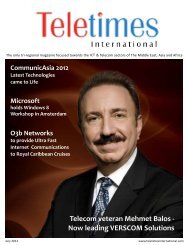Teletimes April 2011.pdf
Teletimes April 2011.pdf
Teletimes April 2011.pdf
You also want an ePaper? Increase the reach of your titles
YUMPU automatically turns print PDFs into web optimized ePapers that Google loves.
Tom‘s Corner<br />
Cross Connect<br />
recent new development<br />
A with the announcement of<br />
AT&T’s planned acquisition of<br />
T-Mobile, a strategic asset of<br />
Deutsche Telekom, which has<br />
already received approval byboth<br />
of their respective boards. While<br />
the news is exciting for many,<br />
it still has huge hurdles to climb<br />
with regard to gaining clearance<br />
from the US Department of<br />
Justice (ensuring no violation of<br />
US antitrust laws and others)<br />
as well as from the FCC. A<br />
clever bid for about 33 million<br />
subscribers, as per latest news<br />
release, would increase the<br />
total subscriber size to around<br />
120 million subscribers for the<br />
new AT&T. This would put the<br />
US carrier first in its domestic<br />
market place in number of<br />
subscribers, while Verizon would<br />
fall to second, having been in<br />
the first position for some time,<br />
since the latest acquisition of<br />
its own. This acquisition would<br />
leave predominantly three large<br />
nationalmobile carriers operating<br />
in the 300 million plus size US<br />
market.<br />
Already, this acquisition, or the<br />
very thought of it occurring has<br />
the third operator CEOmaking<br />
public remarks with regard how<br />
it may effect the marketplace.<br />
Headlines are screaming<br />
already in certain circles how a<br />
monopoly now soon will be a<br />
part of a duopoly, with it vying<br />
clearly with Verizon Wireless<br />
at the top of the market, with<br />
Sprint a very distant third<br />
market player. The regulators<br />
as stated elsewhere in this<br />
document are going to really be<br />
looking carefully at thisnotion<br />
of a merger, most likely on the<br />
city layer also, where potential<br />
conflict of spectrum ownership<br />
as well as possible market<br />
monopolization. There are<br />
obviously pros and cons to ever<br />
consolidation activity. They<br />
remain to be seen at this stage,<br />
for its entirely way too early.<br />
The eagles are flying however,<br />
to pick this apart BTS by BTS it<br />
may seem sometime in the not<br />
so far future.<br />
What this brings may be quite<br />
interesting, depending upon<br />
how things work out. What<br />
is intriguing is the merged<br />
carrier 3G networks are not<br />
currently capable of using similar<br />
handsets. At least not yet, due<br />
to the different frequencies<br />
which each carrier currently<br />
operate their own so-called 3G<br />
networks. AT&T has a plan to<br />
construct a much faster mobile<br />
broadband network than it<br />
currently does, which is using<br />
an extended version of HSDPA.<br />
The latest numbers on the new<br />
CAPEX investment is around<br />
eight billion US dollars and is<br />
predominantly going to be spent<br />
on covering rural areas, as well<br />
as roaming capabilities. There<br />
is hope that the business and<br />
governmental environment may<br />
support such investment for it<br />
must return positive equity to<br />
its investors or why would they<br />
invest in the upgrade? AT&T<br />
will gain access to additional<br />
spectrum, customers (who they<br />
can upsell smart phones and<br />
Apples), denser cell coverage in<br />
some areas (non 3G) and the<br />
fact that both carriers operate<br />
GSM brings many facets into<br />
scope. Additionally, be default,<br />
small as it may be in size now,<br />
but Audi just announced today<br />
that they selected T-Mobile US<br />
to be their wireless carrier of<br />
choice for their new A7 program.<br />
AT&T may win that<br />
business if it completes<br />
the acquisition. What<br />
is interesting further,<br />
is that the automobile<br />
manufacturers are<br />
getting wise and bringing<br />
mobile wireless to the<br />
vehicle,where a version<br />
of broadband and maybe<br />
even m2m, both will be in<br />
many manufacturers over time.<br />
Another way the operators can<br />
develop revenue that is nonvoice<br />
oriented. The metrics are<br />
intriguing.<br />
This act of consolidation may<br />
have considerable lessons<br />
for which others can watch<br />
and learn from. Is there true<br />
synergistic value in the pairing<br />
of the second and fourth<br />
largest operators in the US. Is<br />
spectrum the core component<br />
of the merger? Will the<br />
networks merge their pricing<br />
plans without harming existing<br />
post paid customers? Will the<br />
networks actually be able to<br />
share and bring aboard new<br />
higher revenue smart phones,<br />
which currently can’t operate<br />
on both networks as of yet?<br />
Will the access to both fixed<br />
and mobile broadband at higher<br />
speeds increase? T-mobile<br />
subscribers do potentially and<br />
possibly gain the iPhone but this<br />
is chiefly by having to switch<br />
to a probably proposed new<br />
rate plan from the old AT&T<br />
for them to move to the Apple<br />
program. Bandwidth caps and<br />
throttle down bandwidth is<br />
currently already in practice<br />
by each carrier respectively,<br />
however some sort of continuity<br />
of pricing, marketing, handsets,<br />
development on the 4G future<br />
networks and other very<br />
Tom Wilson<br />
CEO & Executive Managing Director<br />
SAMENA<br />
important activities will be quite<br />
complex.<br />
Carriers such as Etisalat Group,<br />
STC Group, Orange, Batelco<br />
Group, Orascom, MTN Group<br />
and others in the SAMENA<br />
region who already or will have<br />
similar statistics in subscribers<br />
are all facing some of the same<br />
issues. Where does conformity<br />
to standards across borders<br />
come to play and how far will<br />
consolidation go. The issues<br />
are actually quite different for<br />
the SAMENA region carriers<br />
as opposed to those in North<br />
America or in other large<br />
population developed markets,<br />
where there may be one single<br />
policy maker / regulator across<br />
the board for the entire one<br />
hundred twenty million plus<br />
subscribers. There is the good<br />
side, where mobile operators<br />
such as Verizon and AT&T can<br />
concentrate on one body such<br />
as the FCC, which is responsible<br />
for regulations and policy<br />
(sometimes stretching their<br />
understanding of what policy<br />
making and policy enforcement<br />
actually mean and for what they<br />
are authorized to enforce and<br />
etc.). However with one entity<br />
for the most part such as the<br />
FCC making creating regulatory<br />
framework and policies (within<br />
certain restrictions) such as net<br />
neutrality recently, having only<br />
one policy maker / regulator<br />
15Apr - 14May 2011<br />
www.teletimesinternational.com<br />
23





